Using Wafer Paper & Frosting/Sugar Sheets
Makes: one 4” diameter flower
Note: this pattern is for a slightly smaller version than the original 6.5 inch size so that only one sugar sheet would be needed. Reduce or enlarge pattern pieces to adjust to desired size. Number of petals per row may need to be increased slightly for larger flowers or decreased for smaller flowers. See end of tutorial for suggested petal counts for 6.5 inch.
To change the look a bit, replace center bud/Row Six with varying sizes of pearl or metallic dragees glued in place with royal icing.
Wafer paper, sometimes called “edible rice paper” is a slightly translucent, sugar free starch based paper. For more information, please see my blog. I’m certainly no expert and am still learning. Many books have been written about wafer paper uses and are available online if you have other questions. Cake Central also has information here. Wafer paper can be purchased online from several sources but most carry 8.5 x 11 inch sheets. Chef Rubber sells 50 sheets that are half sheet pan sized for about $15, which is the size I used. Substitute 2 smaller sheets if needed.
I used water as petal glue but you may want to try substituting alcohol, (flavored vodkas are nice) piping gel, gum paste glue, thinned royal icing or shortening. I’ve only tried water and vodka to date. Just remember to use only a small amount. Less is more is true for both the water and royal icing “glues.”
DISCLAIMER: I live in a cave. Almost. The lighting is horrible. If I’d waited for a sunny day to do the filming, you may have been waiting a LONG time. Thanks in advance for having a sense of humor about my first video clips and the lighting conditions. Did I mention that I also had to learn how to shoot and edit a video while attempting this tutorial? I’m such a novice. In a cave AND under a rock!
Supplies:
One 11.5 x 16.25” sheet OR Two 8.5 x 11 plain wafer paper sheets
One 11.5 x 16.25” sheet OR Two 8.5 x 11 plain wafer paper sheets
One black 8.5 x 11” Sugar Sheet by Wilton
White royal icing in piping bag with #3 round tip
Small artist’s brush
Sharp craft scissors
Small dish for water
Round saucer
Plastic mini clothespins by Wilton(baby shower section party/craft stores)
Parchment or waxed paper
Aluminum foil
Template for petals and base printed at 100% to cardstock
Layout page for strip cutting printed at 100% to cardstock or paper
Water
Optional:
Large paper cutter or trimmer for cutting paper strips to petal size
Dragees
Part 1: Printing and Cutting
Both the pattern and layouts can be saved to your computer by clicking on
the image above or below. This should take you to another screen where you
can scroll to the image you'd like and then "save as" to your files.
Print template and cut pattern pieces from card stock.
You'll know you've printed at 100% if the Base 1
circle is just under 2 inches across in your printout.
the image above or below. This should take you to another screen where you
can scroll to the image you'd like and then "save as" to your files.
Print template and cut pattern pieces from card stock.
You'll know you've printed at 100% if the Base 1
circle is just under 2 inches across in your printout.
This will be used to cut the base patterns (if desired) and
as a guide to cut strips and then rectangles for sizing the
frosting sheet into petal sized pieces for hand cutting.
Size the wafer paper into strips roughly the size of the outer petals using a paper cutter or scissors. Cut strips into rough rectangles. Stack and cut up to four layers at a time using card stock pattern piece as a guide. Cutting more than four layers at a time may cause the edges to tear or crack rather than producing a nice clean edge.
The layout page is for sizing the frosting sheet into strips and shouldn’t be
used for pattern pieces. Except for possibly the base pieces. If you try to
take a shortcut and cut through the layout paper and frosting sheet at once,
you’ll end up with little shreds of paper embedded in the sides of your cut petals.
Be sure to use the pattern pieces that you’ve pre-cut instead.
When cutting the petals, I found it easiest to start at the lower edge and cut upwards toward the point then down the point on the other side. The third cut is across the base or bottom of the petal. This helps make getting into the tiny curve near the point a bit less difficult.
The rough or textured side of wafer paper should be facing up for better folding and less chance of tears. This petal pattern isn’t completely symmetrical so the assembled petal pieces will not look completely even or be perfectly spaced. The goal was to make them not seem TOO perfect or cookie cutter looking.
Remove the black sugar sheet from its foil-lined pouch. Remove clear plastic liner from the sugar sheet. Note that the under side has a shiny surface. This will be the back or under side of the petal so make sure the dull side is up during cutting. Cut inner petals and Base circles 1 or 1-5 from black sugar sheet one at a time. There is no Base 6.
Place cut petals in airtight bag between small rectangles of parchment or waxed paper until ready to assemble. If your frosting sheets dry out, there are some things you can try to rehydrate them. This Cake Central link will take you right to the frosting sheet emergency department. No waiting. The cut frosting sheet or inner petals can also be rehydrated if you find they are not bending as easily as you’d like. They cannot be rehydrated after being attached to the wafer paper petal.
If you haven’t worked with either of these materials before, you may want to play with some scraps to get the feel of just how little moisture is needed, what the drying time is in your locale and what happens when either of them get too wet.
If you haven’t worked with either of these materials before, you may want to play with some scraps to get the feel of just how little moisture is needed, what the drying time is in your locale and what happens when either of them get too wet.
Try to avoid moving the black inner petal around or repositioning it too much after it’s on the wafer paper. The black can transfer quite easily while it’s wet. Having a slightly dampened paper towel to clean your fingertips is handy.
Part 2: Gluing Petal Layers and Shaping
a
Starting with Row 1 petals: Glue black inner petals to outer wafer paper petals by painting a small amount of water to the shiny or back side of the black petal and carefully placing on the rough or textured side of the wafer paper.
It is not desirable to adhere the entire surface of the inner petal to the outer. Leaving a dry edge around the upper most part of the petal allows more flexibility during the petal shaping. It also helps insure that the black from the frosting sheet doesn’t rub off on the wafer paper while attaching the two pieces together.
What’s important is that the bottom edge and center of each petal be firmly attached, so focus your efforts here. Just make sure that the bottom edge of both pieces align somewhat and that the black inner petal is centered from the sides.
Position the petal lengthwise in front of you. Gently fold each side of the petal toward the center while supporting the entire length of the petal to prevent stress cracks until the petal is clamped. Firmly finger press the base only and apply a small amount of water or flavored vodka to the inside the fold. Hold firmly until clamp is applied. Work on one petal at a time rather than trying to do this assembly line style. It’s much easier to shape the petal while it is still damp.
Clamp with a mini plastic clothespin until partially dry or set. It’s best to work one row at a time and start applying the petals to the base as soon as you finish assembling all the petals for one row. This way they have a few minutes to set up in the royal icing before you add the next row. More importantly, for all but Row 1, it’s best that the clamped area of the petal is still a little flexible so that you can gently bend it into a soft “L” shape to have a flat contact point with the royal icing/base.
Repeat with all petals up to and including Row 4. Drying time will vary depending on humidity but 10-20 minutes or less is about right. Bone dry isn’t needed, just dry enough that the folds aren’t coming apart.
Row 5 petals: Use the same method of gluing the petals together as above but instead of folding each side toward the center, gently fold over just edges of the petal to meet each other to create a more open petal. Clamp to dry slightly then assemble Row 5.
Row 6 Petals: Glue outer petals to inner petals. Using one of the four assembled petals, gently fold the sides toward the center but overlap like a folded letter or into thirds. Carefully open the top of the petal by fanning slightly. This will be the center of the bud for Row 6. Glue base and clamp to dry slightly. To form the remaining 3 petals, bring the bottom sides together in the center and clamp to dry slightly.
Row 6 Bud: Assemble Row 6/Center bud by wrapping 3 petals around the 4th tighter wrapped bud petal. You may have to trim a bit from the bottom of the completed bud in order for it to set down in the flower a little lower than the petals in Row 5.
Part 3: Assembly of Flower
a
Note: Not shown on the video: place the base on a piece of aluminum foil before putting it on the saucer. If you use too much royal icing, the base can dissolve or crumble. Best to be safe so that your flower won’t stick to the plate.
Remove clamps from dried petals. Place the Base 1 circle in the center of the small saucer. The saucer will act as a turntable of sorts during assembly.
Starting with Row 1 petals, place the petals side by side around the outside edge of Base 1 with the bottom end of the petal touching the inner ring. The inner rings on each base help make sure that your flower doesn’t end up in an oval shape. Adjust as needed so that petals are laying flat and are evenly spaced with no overlap. You can assemble the entire flower on top of Base 1 if you’d rather eyeball the circles instead.
If desired, insert Base 2 into the flower center and secure with a tiny dab of royal icing. Pipe a ring of royal icing over the ends of petals in Row 1, about ¼ inch up the base. Spread the piping evenly to the inner ring of Base 2. Repeat the placement of petals for Row 2 following the same method. However, center the first petal in the next row over two of the petals in Row 1, so that no gaps between the petals in Row 1 are showing. The petals will naturally start to stand up as you work toward the center of the base due to the height of the petals beneath.
Press the very bottom edge of the petal firmly into the royal icing to be sure the surfaces make good contact. This also causes a bend in the petal stem which helps the petals stack better.
For Row 6/Center bud, pipe a dot of royal icing in the small remaining bare center of the base and position the bud inside. You may need to trim the base of the bud if it is taller than the surrounding row. The center bud should end up being shorter than the rest of the flower so that you are looking down inside of it.
Alternative: replace Row 6 with a few dragees glued into place with small dots of royal icing.
Part 4: Notes and Simple One Layer Flower
a
Be sure to let the royal icing in your finished flower dry completely before handling too much or placing it on a cake, at least overnight. If you don’t plan on assembling your flower right away, store the petals in an airtight bag or container until then. Finished flowers can be stored in the same manner if not being used immediately. I live in a fairly humid climate and have left my completed flowers out and unprotected for weeks with no issues.
After flower has dried completely, attach it to dried fondant on your cake with royal icing. The moisture from fresh fondant may warp the wafer paper petals so it’s best to wait until the fondant has hardened before attaching your finished flower. You can also prepare a small circle or other shape of fondant in advance and let it dry thoroughly to act as a shield between any damp fondant and your lovely bloom.
For a simple one-layer flower: cut outer or inner petals only of solid color frosting sheet or wafer paper. Glue and clamp petals as above. If you prefer a different center to your flower, substitute the Row 6 with pearl, black or silver dragees attached with a dot of royal icing. Half the cutting but all of the beauty!
Note: the smallest amount of moisture between the petals and a little finger press will glue the petal edges together and coax them into a sturdier shape if you have some rebels that don’t want to stay put.
Please send me a PM on Cake Central or comment here if you have any questions.
Thanks for trying them out!
Deborah
Suggested petal count for 6.5 inch diameter flower:
Row 1 – 16 outer/16 inner
Row 2 – 16 outer/16 inner
Row 3 – 12 outer/12 inner
Row 4 – 10 outer/10 inner
Row 5 – 5 outer/5 inner
Row 6 – 4 outer/4 inner

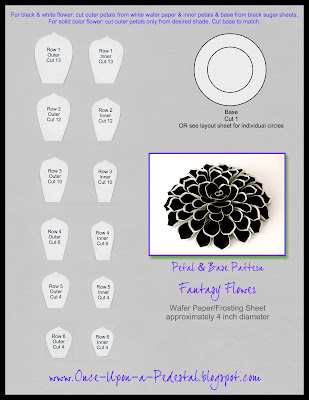
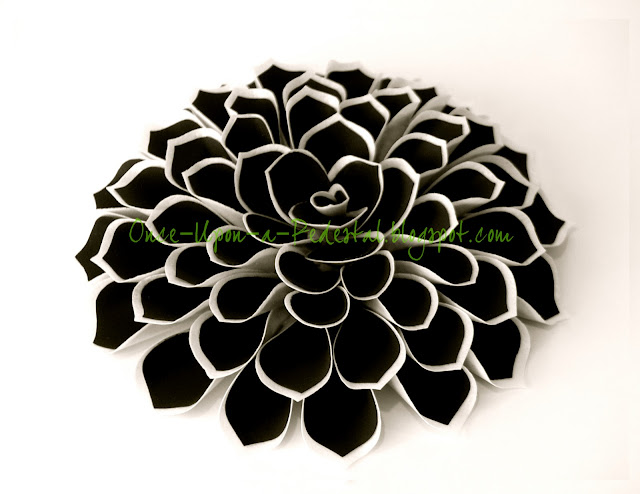

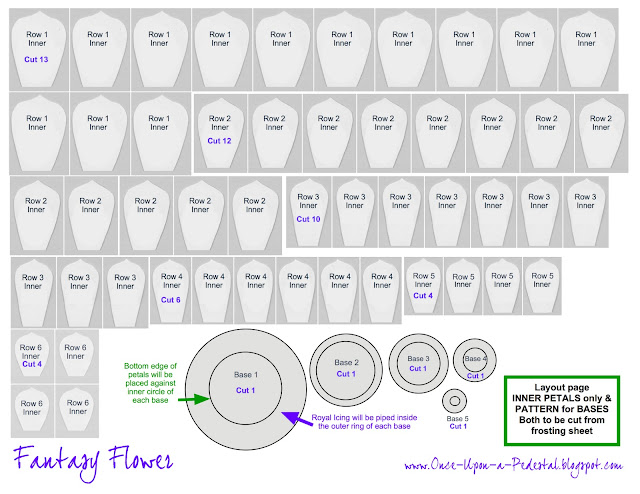
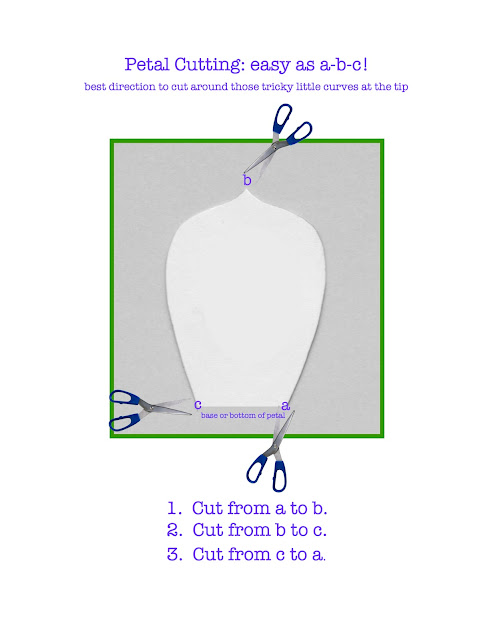





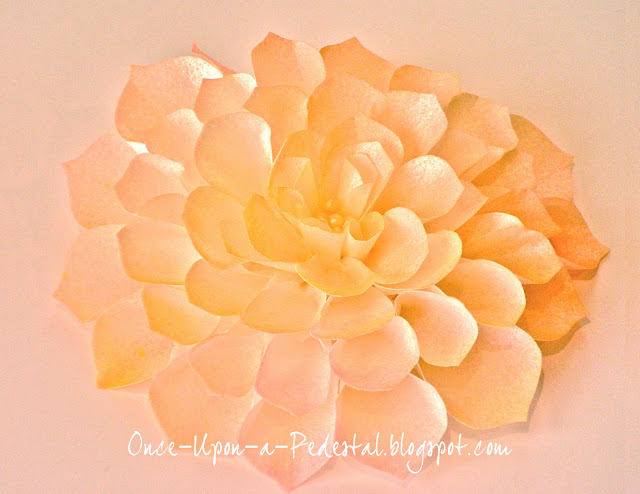

15 comments:
Beautifully done! Thank you, and congrats on such a well-received tutorial! : )
Thanks Baking Buddy! And thanks again for reviewing it with your fine eye for detail!
Thanks Nicole and glad to have you following my adventures!
Outstanding work! Simply amazing. I first found it on cakecentral then I followed it here :). You have done fantastic job with the tea set also. Its totally inspiring.
Thank you for posting such a great tutorial. When I first saw the picture of this beautiful flower on CC I knew I must try it ASAP. It's my first time working with the frosting sheets so I played around with the scraps first.
Everything was fine until I tried to bend and shape the petals. Every one of them cracked no matter how slow I tried to bend it or if I tried to add some moisture by steam from a pot of water. I wasn't able to listen to you videos because iPads don't play flash. Can you help me please?
Thanks
Kristy
Kristy, - I'm SO sorry that you're having trouble. You must be really discouraged about now. The only reasons for the sheets to crack are that the sheets weren't hydrated or moist enough or that too much pressure was used to bend them. The bend or soft fold only takes place at the bottom of the petal. One thing you're missing by not being able to see the videos is the method of folding them over. You must use both hands and support the entire length of the petal while you're folding/bending. I'll try to get some still shots from the video to help. Did you make sure to keep your cut petals in the airtight foil bag? I only pull out 1 or 2 to work on at a time since they're so prone to drying out quickly. What brand/type of frosting sheet are you using? That may also be a factor. They're not all the same thickness. Please send me an email at dstauch45@gmail.com and I'll email you some photos. Hope this helps!
this is beautiful (but i really dont have the patience :-0) do you sell them?
Zakia: Thanks! As I don't have a licensed kitchen and these are a food product, I am unable to sell them. : ( They really aren't too bad to make and could be made in other mediums as well such as fondant or gumpaste if those are easier for you. Hope you'll give them a try one day. Happy Caking!
Absolutely stunning thanks for sharing! I make art jewellery in polymer clay, but have not tried sugar work although my daughter took a course years a go.
Jackie
Thanks for the kind words Jackie! You'd be a natural at sugar art if you've worked with clay. Hope you'll give it a try sometime!
Please tell us how do u colored the rice paper? In pink w outlined petals, in goldish pearl?
Flowers are outstanding beautifull, but I want to get them colored, not monochromatic.
Thank u for the answer in advance.
Wafer paper can be colored using an airbrush or the canned spray colors offered by Wilton. There are other methods as well but I used the Wilton cans for the pink or coral flower. A light spray of pink / dry time / a light spray of yellow.
Hope this helps!
This post is very useful. Thnks for sharing it.
Edible Sheets | Edible Cake Printers
Found your post interesting to read. I cant wait to see your post soon. Good Luck for the upcoming update.This article is really very interesting and effective. Take a look on this website Click Speed Test
Post a Comment